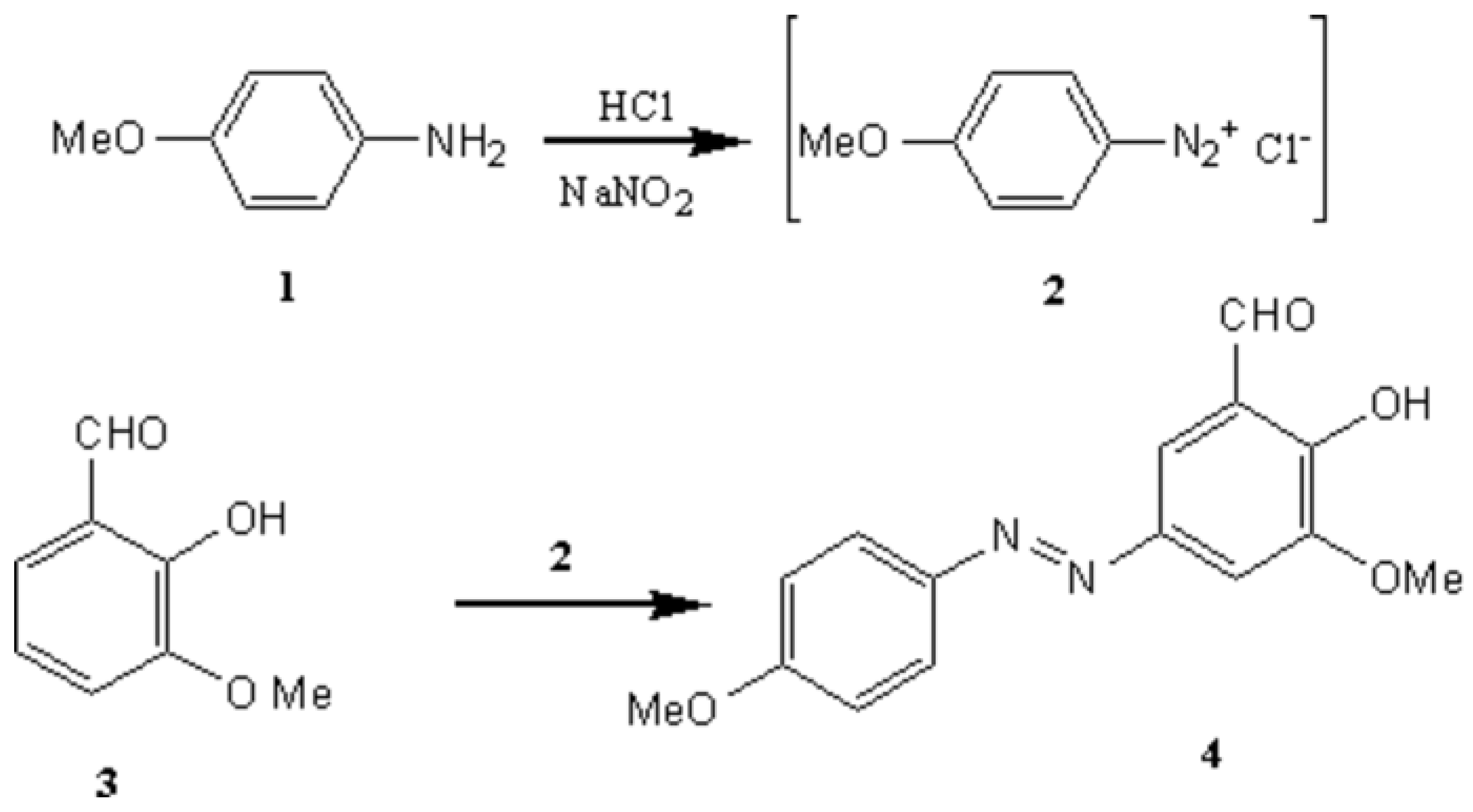Diazo compounds have interesting biological activities [1,2,3,4]. It was shown that the presence of an azo functionality in many compounds is essential for the exhibition of pesticidal activity [5]. In addition, the existence of the methoxy groups on some molecules enhanced the biological activities [6]. As such, we synthesized a new aldehyde 4 possessing an azo as well as the methoxy groups. Reaction of this novel azoaldehyde with various aromatic amines afforded the corresponding Schiff bases. Their antibacterial and antifungal activities are under study to be presented in the near future.

Experimental: A solution of aqueous HCl (1.61 mL, 17.92 mmol ) in 20 mL water was added to the p-anisidine 1 (1.00 g, 8.12 mmol). It was stirred and cooled to 0 oC and then an aqueous solution of NaNO2 (0.62 g ,9.00 mmol ,8 mL H2O) was added dropwise. The so-formed diazonium chloride 2 was consecutively coupled with o-vanillin 3 (1.24 g , 8.12 mmol ), dissolved in 10.00 mL of aqueous 2N NaOH (0.80 g, 20.00 mmol ). The reaction mixture was stirred for 1 hour at 0 oC, and then allowed to warm-up slowly to room temperature. The brown precipitate thus obtained was filtered and washed with H2O (3 x 20 mL ). Then it was dissolved in CH2Cl2 and dried (Na2SO4), filtered, and the solvent was evaporated under reduced pressure [7]. The crude product was purified by column chromatography (silica gel, CH2Cl2/n-hexane, 1:1, V/V as eluant) to give 2-hydroxy-3-methoxy-5-(4-methoxyphenylazo)benzaldehyde 4 (1.77 g, 6.18 mmol) in 76.20 % yield.
m.p. 169-171 oC.
IR (KBr) (cm-1): 1600 (C=C) , 1670 (C=O) , 3030-3580 ( OH ) .
1H-NMR (CDCl3) (250 MHz) δ (ppm): 4.01(6H, s, 2OCH3), 7.07-8.26 (6H, m, aromatic hydrogens), 10.06 (1H , s, CHO), 12.78 (1H, br, OH).
13C-NMR (CDCl3) (62.90 MHz) δ (ppm): 56.82 (OCH3), 108.70-125.19 (aromatic carbons), 196.91 (CHO).
MS (m/z, %): 286 (M+, 65.5), 151 (  , 19.8), 135 (MeOC6 H4N2, 40.3),107 (MeOC6 H4, 100), 92 (C6H4O, 20.3).
, 19.8), 135 (MeOC6 H4N2, 40.3),107 (MeOC6 H4, 100), 92 (C6H4O, 20.3).
 , 19.8), 135 (MeOC6 H4N2, 40.3),107 (MeOC6 H4, 100), 92 (C6H4O, 20.3).
, 19.8), 135 (MeOC6 H4N2, 40.3),107 (MeOC6 H4, 100), 92 (C6H4O, 20.3).Supplementary materials
Supplementary File 1Supplementary File 2Supplementary File 3Acknowledgment
The authors thank the Shiraz University Research Council for financial support (Grant No. 81-SC-1495-C191).
References
- Pathak, P.; Jolly, V.S.; Sharma, K.P. Orient. J. Chem. 2000, 16(1), 161–162.
- Pathak, P.; Jolly, V.S.; Sharma, K.P. Orient. J.Chem. 2000, 16(3), 493–494.
- Alka, Pradhan; Vinod, Pradhan; Jolly, V.S. Orient. J. Chem. 1994, 10, 73–74.
- Jolly, V. S.; Pathak, M.; Jain, R. J .Indian. Chem .Soc 1993, 70, 505–507.
- Samadhiya, S.; Halve, A. Orient. J. Chem. 2001, 17(1), 119–122.
- Halve, A.; Goyal, A. Orient. J. Chem. 1996, 12(1), 87–88.
- Furniss, B. S.; Hannaferd, A.J.; Rogers, V.; Smith, P.W.G.; Tatchell, A.R. Vogel's Textbook of Practical Organic Chemistry, 4th ed.; Longman Inc.: New York, 1981; p. 716. [Google Scholar]
- Samples Availability: Available from MDPI.
© 2004 MDPI. All rights reserved.